Introduction
In early 2023, my partner and I spent some time travelling through Central and South America. Cenote diving was the second diving stop on our trip and this report follows an earlier one from Cozumel in Mexico.
At the point we arrived in Mexico in January 2023 I’d completed around 60 dives since completing my Open Water certification in 2014. Throughout that time, in reading and learning about diving I’d always been intrigued by cavern diving but had assumed it was out of reach for a relatively inexperienced diver. However as I delved deeper into the world of cavern diving, I discovered you can dive in caverns with only an open water certification! With Mexico being one of the best places in the world to dive in caves, we decided to book in a couple of dives.
What is Cavern Diving?
Cavern diving – like cave diving – is where you leave the open water and enter an overhead environment. During my own research it was clear that you need a lot of specialist training before you can dive in caves. So how can you be allowed to dive in a cavern as a relatively inexperienced diver if caves and caverns are one and the same? Where does a cavern end and a cave start?
It’s true (and somewhat confusing) that caverns are just caves. So in cavern diving you’ll still be diving in an environment where you can’t simply ascend to the open air in an emergency. However there are a number of important distinctions between what separates a cave dive from a cavern dive and a cavern dive from a regular open water dive.
1. Access to Daylight
Cavern divers must remain within sight of daylight at all times. Technically this means being no more than 60m (200ft) from an entrance to the cave. In practice it’s a little more complicated as many cavern entrances are linked up underground and so cavern dives can penetrate further than 60m from where you actually enter the water. But as long as you’re never more than 60m from any access to the surface, you’re cavern diving. To go beyond this limit, you’ll need to embark on a cave diving course.
2. Guides
While as an open water diver you can dive with only you and your buddy, in a cavern you’ll need a guide. Cavern dive guides need to be full cave diving trained and diving in full cave gear. We chose the excellent Under the Jungle – more on them later.
3. Gas Planning
Finally you also need to change your gas planning to use the ‘rule of thirds’. This means you split your air into three parts. The first is for the dive out, the second for the dive back (i.e. you turn the dive when you have two thirds of your gas remaining) and the third is kept as a reserve in case of difficulties underwater.
Cavern Diving in Cenotes on the Yucatan Peninsula in Mexico
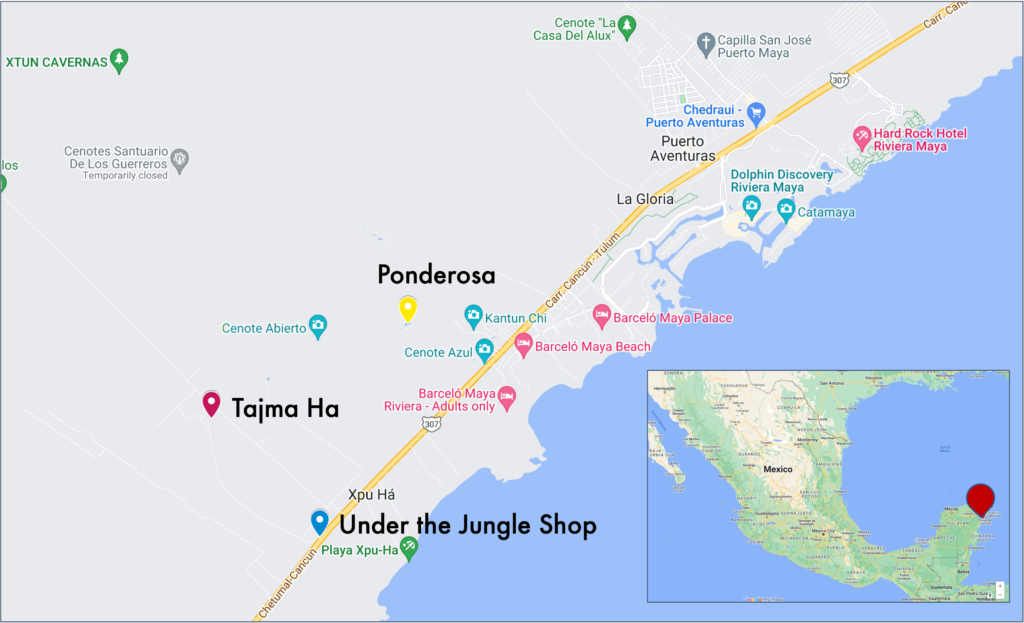
The Yucatan Peninsula on the East coast of Mexico is famed for its vast networks of underwater caves making it a dream destination for cave divers. These same caves are often accessed by sinkholes (or ‘cenotes’ in Mexico – a word derived from a Mayan language to denote accessible water) which provides many opportunities for cavern diving.
Cenotes are sacred places for the Maya people. Historically, they were their only source of freshwater in the middle of the jungle. Scientists also believe the Maya used cenotes as places of human sacrifice to appease their gods and end periods of drought.
We travelled to Mexico from the UK and first visited Cozumel before our cenote adventure. See this post for more information on how best to get here. From Cozumel you simply take the ferry back to the mainland and you’re in the heart of cenote country.
Under the Jungle
There are many dive shops offering guided trips to the cenotes in Mexico. However as this was our first cavern dive, we wanted to dive with one of (if not the) best shop in the region. We read many reviews and recommendations and opted to dive with Under the Jungle (UTG). In peak season you may have to book as many as eight weeks in advance.
UTG are certainly not the cheapest at US$100 per dive but for that price you receive:
- A private guide for your group (i.e. you only dive with people you know – for us that meant one guide to two divers)
- Probably the most thorough dive briefing I’ve had (complete with slides, photos and maps)
- Nitrox; and
- Pickup from your accommodation (see below) and lunch
The shop is located near the town of Puerto Aventuras. The shop is a little difficult to get to but if you live within their catchment area they’ll pick you up from your accommodation. We stayed in Tulum which was a half an hour ride by colectivo (a form of shared public bus common in Latin America). We paid MX$40 (~£2) per person one-way.
One of the biggest plus points of UTG is that given the higher fee, you’re not in a rush. Often when you’re out on dive boats who have a morning and afternoon schedule, it can often feel rushed before and between dives. But we never felt rushed with UTG – we had all day to take our time with the briefing, and with pre-dive set-up and getting us both comfortable.
Rental Gear
After arriving at the shop, we filled out all the usual forms and squeezed into our rental gear. As UTG is a cave diving shop, they use backplates and wings (BPW) for buoyancy rather than the more common (in recreational diving) jacket style BCDs. This was my third time using BPWs (after Scapa Flow and Portofino) – when I finally buy my own gear, I’m definitely going the BPW route. The rental gear was generally ok but they didn’t have a huge selection of sizes. My guess is that given the price point and type of diving, most customers are relatively experienced and have their own gear.
Dive Briefing
We stashed our gear in a crate, analysed our nitrox and loaded up the truck before moving inside for a briefing. The briefing was without doubt the most thorough I’ve had – credit to Nat for putting together such a detailed information pack and Arya for delivering it.
Arya walked us through a series of slides on cavern diving, safety and the caverns themselves, all featuring some of the incredible photos shot by the UTG team (check out their Instagram). All in all we likely spent 45 minutes discussing the dives with Arya answering all our questions. Despite a few nerves at the beginning of the day, after the briefing we felt much more comfortable going into our first cavern dive.
The Diving – Cenote Ponderosa (Garden of Eden)

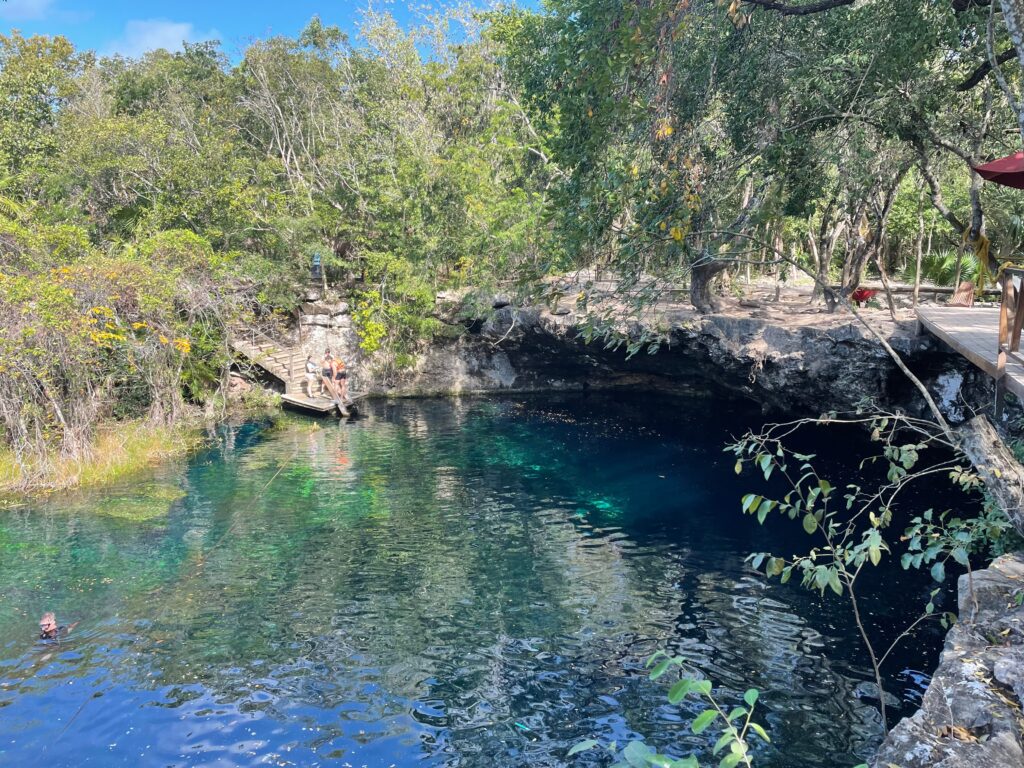
Our first dive was in cenote Ponderosa (also known as the Garden of Eden), a short ten minute drive from the UTG shop in Arya’s pickup truck. There were lots of cars parked up when we arrived, but thanks to our lengthy briefing it looked like most were already in the water and would be on their way out by the time we splashed in.
Before gearing up, we walked down to the water to take a look at where we’d be diving. The cenote entrance is a beautiful collection of green and blues with the water’s edge surrounded by trees. A small concrete platform by the water was loaded up with tanks and the water already filled with teachers leading dive courses – a mix of cavern and cave.
We returned to the truck to start gearing up. I dived in a 5mm long wetsuit with 5mm hood but my warm blooded Australian partner needed two 5mm layers and a vest. Our guide, Arya was diving dry. We strapped on our tanks and walked down to the water.
As this was our first dive with UTG, Arya wanted to complete a quick check of our diving ability and so we jumped in the water for a quick swim around in a circle to demonstrate we knew what we’re doing. Quickly satisfied, we then moved over to the cenote entrance.
Arya had reminded us in our briefing that diving in freshwater introduced additional challenges: predominantly the lower water density. In freshwater you less weight than in salt water for the same gear setup. The lower density also means small changes in the amount of air in your BCD have a bigger impact than they might in the sea.
We put our head underwater and made our way into the dark. I felt a mixture of excitement and nerves knowing our exit to fresh air was now blocked by the rocky ceiling. Those nerves were quickly abated as we progressed through the first section of the cave and saw the most incredible light beams flooding the cave from above. It was a breathtaking sight. We continued through the cave, passing another group of divers on their way out.
The rule of thirds had me a little concerned that the dive would be relatively short. But given the shallow depth of the diving (max depth: 11.5m) our gas consumption wasn’t a problem. We reached the end of the cavern line – the point at which diving any further would turn this into a cave dive – before breathing a third of our gas and so we turned around. After swimming back past the incredible light beams, we were back at the surface.
The Diving – Cenote Tajma Ha
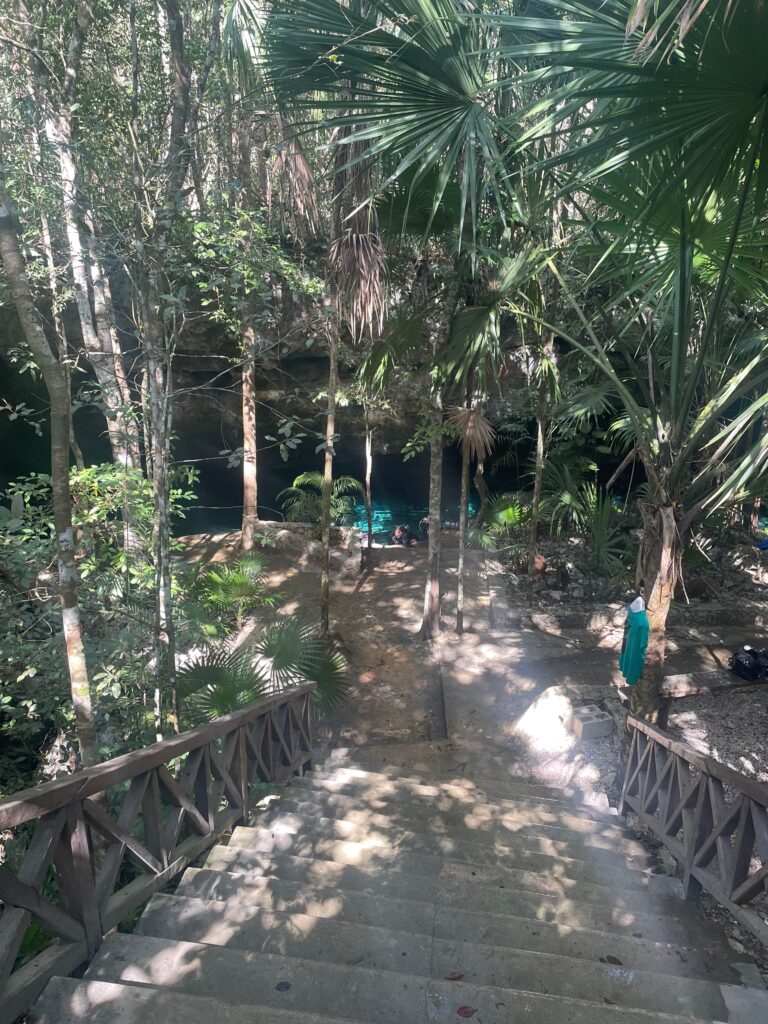
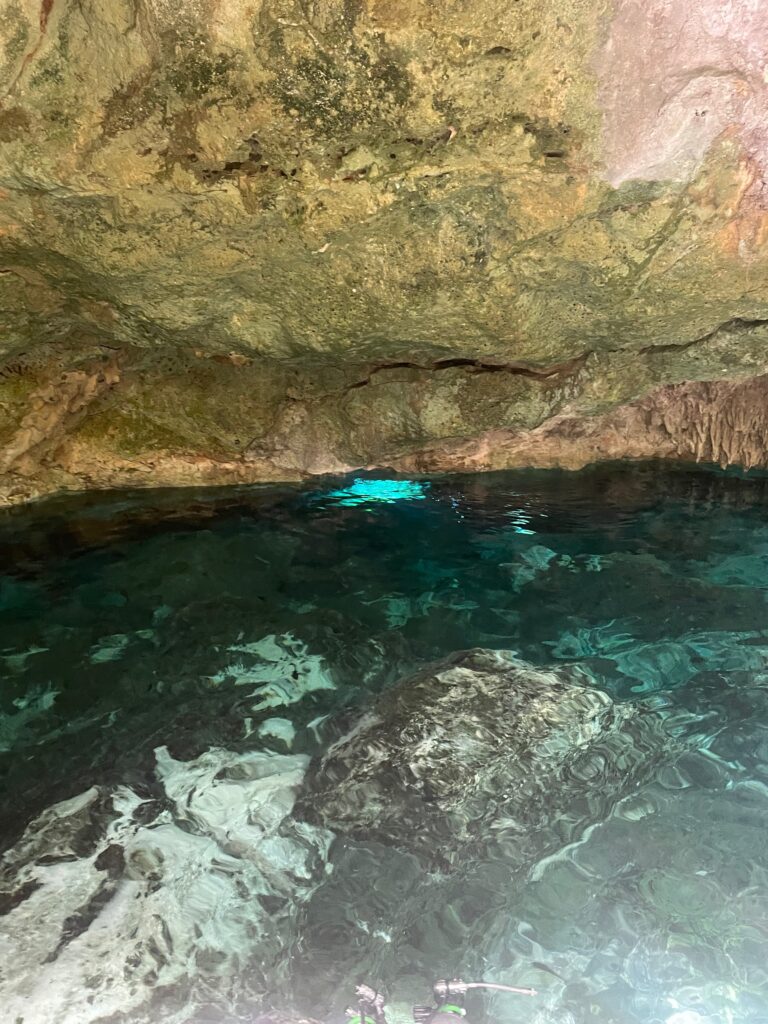
Our second dive of the day was in Tajma Ha, conveniently located five minutes behind the UTG shop. We parked up the truck and walked down to the cenote entrance. The entrance to Tajma Ha is much smaller than Ponderosa. You can also take one of two routes from the entrance. We would take the left entrance and return via the right.

We geared up, walked down to the cenote entrance and jumped in the small open water area above the entrance to the caverns. After a quick equipment check we descended a couple of metres and started to move through the caves. As with the first dive, the dive was shallow with our deepest point through the caves at only 14m. The cavern route does have lots of ups and downs, a real test for the ears given you’re moving between 2m and 10m where the pressure changes are the greatest.
After 25 minutes swimming through the cave system, we reached the end of the cavern line and turned the dive. We headed back towards the exit but stopped 20m before the exit to surface in a large cave filled with sleeping bats – not something you usually see on a dive!
The two cavern dives were some of the best I’ve ever experienced – if you’re in Mexico and considering it, don’t hesitate!
Dive Summary
- Date: 19th January 2023
- Dive Log: #67 and #66
- Max depth: 14m
- Max water temp: 25C (77F)
- Min water temp: 24C (75F)
- Dive Shop: Under the Jungle
- Price per dive: US$100 (including rental equipment)
| Dive # | Date | Dive Site | Duration (mins) | Max Depth (m) | Avg Depth (m) | Temp High (C) | Temp Low (C) |
| 67 | 19/01/23 | Ponderosa | 60 | 11.5 | 5.9 | 25 | 24 |
| 68 | 19/01/23 | Tajma Ha | 55 | 14.4 | 6.7 | 25 | 24 |
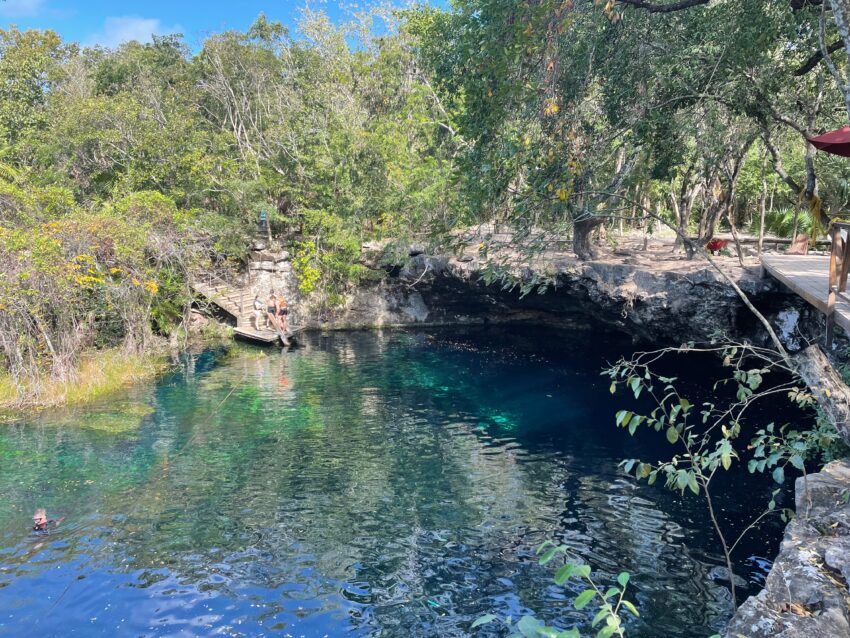
1 thought on “Scuba diving in cenotes: Mexico cavern diving”